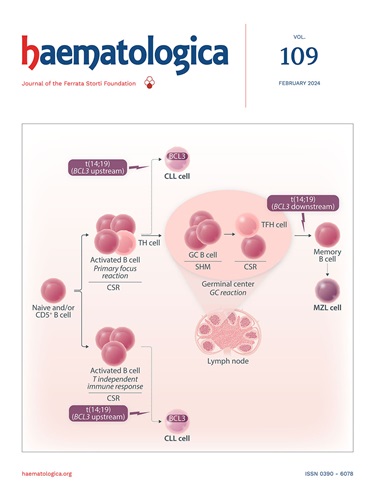Reporting blast percentage for response assessment in acute leukemias: recommendations from an EHA/ELN expert panel.
IF 7.9
1区 医学
Q1 HEMATOLOGY
引用次数: 0
Abstract
Evaluation of bone marrow blast percentage is paramount to response criteria in acute leukemias. There is an identified need within the framework of updated laboratory practices to reduce inconsistencies in methodologies used by clinical laboratories to report blast values and clarify aspects of reporting. Representatives from international specialised working groups including the European Hematology Association (EHA) Diagnosis in Hematological Diseases Specialised Working Group and the European LeukemiaNet (ELN) produced consensus guidance for harmonised blast assessment to define response categories in acute leukemic patients. These address sampling best practice, key considerations for generating the most accurate blast enumeration and the limitations across the methodologies in acute lymphoblastic leukemia (ALL), acute myeloid leukemia (AML) and acute leukemia of ambiguous lineage. An integrated reporting scheme for deriving blast percentage is provided for ALL and AML. This incorporates results from appropriate measurable residual disease assays with morphological crosscheck. The practical guide and approach presented herein should facilitate uniform reporting standards both within clinical trials and in broader clinical practice.报告急性白血病反应评估的爆炸百分比:EHA/ELN专家组的建议。
评估骨髓母细胞百分比是最重要的反应标准在急性白血病。在更新的实验室实践框架内,确定需要减少临床实验室报告爆炸值所用方法的不一致,并澄清报告的各个方面。来自国际专门工作组的代表,包括欧洲血液学协会(EHA)血液学疾病诊断专门工作组和欧洲白血病网络(ELN),为统一blast评估制定了共识指南,以确定急性白血病患者的反应类别。这些内容涉及采样最佳实践,生成最准确的blast计数的关键考虑因素以及急性淋巴细胞白血病(ALL),急性髓性白血病(AML)和谱系不明确的急性白血病的方法局限性。为ALL和AML提供了一个综合的爆炸百分比报告方案。这结合了适当的可测量的残留疾病分析结果和形态学交叉检查。本文提出的实用指南和方法应有助于在临床试验和更广泛的临床实践中统一报告标准。
本文章由计算机程序翻译,如有差异,请以英文原文为准。
求助全文
约1分钟内获得全文
求助全文
来源期刊

Haematologica
医学-血液学
CiteScore
14.10
自引率
2.00%
发文量
349
审稿时长
3-6 weeks
期刊介绍:
Haematologica is a journal that publishes articles within the broad field of hematology. It reports on novel findings in basic, clinical, and translational research.
Scope:
The scope of the journal includes reporting novel research results that:
Have a significant impact on understanding normal hematology or the development of hematological diseases.
Are likely to bring important changes to the diagnosis or treatment of hematological diseases.
 求助内容:
求助内容: 应助结果提醒方式:
应助结果提醒方式:


